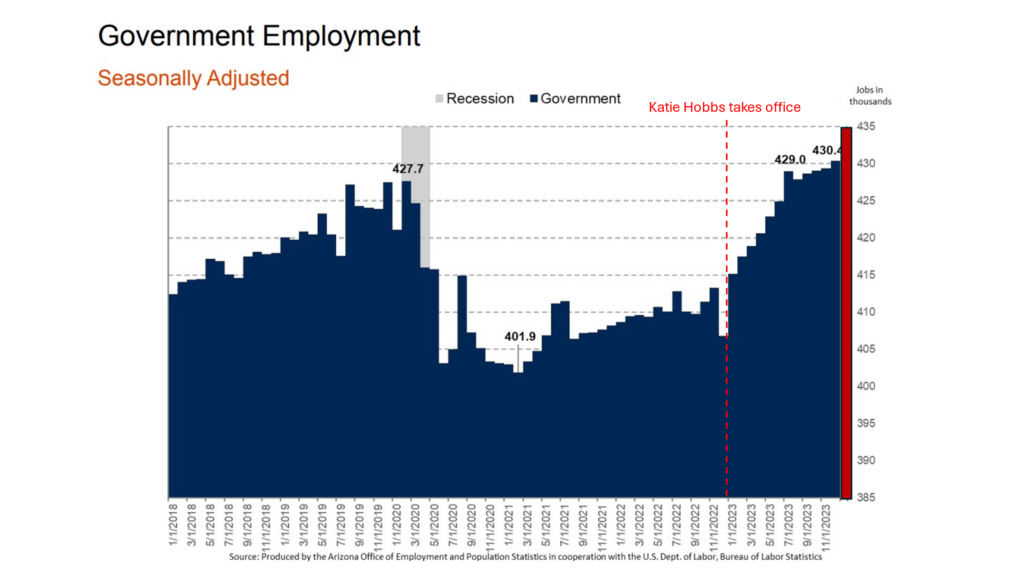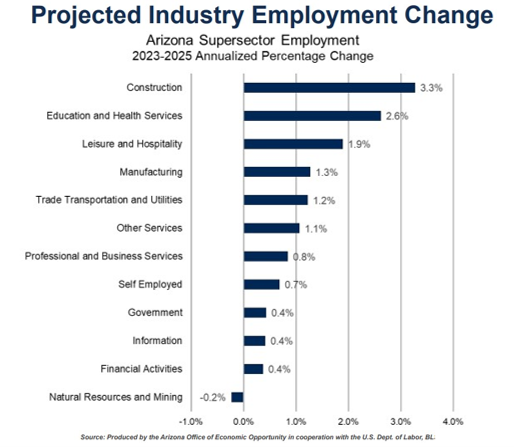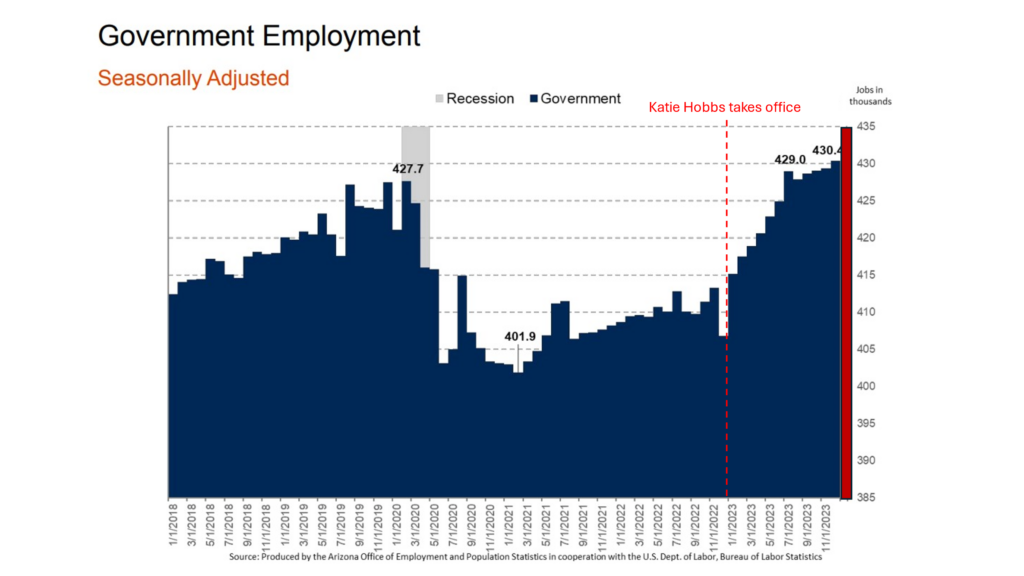Executive Summary
Katie Hobbs loves giving herself nicknames. Her first was the self-described “veto queen” and lately she’s taken to calling herself “Katie Jobbs.” In a recent post on social media, the Governor claims that she has “created 86,400 jobs” – but a look at the underlying data raises cause for significant concern, as job growth is overly dependent on the expansive growth of government, while traditional economic drivers for the state have performed vastly below expectations.
That’s right, in accordance with the philosophy of many big government socialists, Hobbs has kickstarted that sector and used it as an economic success story.
The underlying employment trends point towards a big red warning sign that reads, “DANGER!”
Here’s a chart that encapsulates the issue:

Taxpayer-funded government jobs have exploded since Governor Hobbs took office, meanwhile industries like construction, manufacturing, and hospitality are hemorrhaging jobs.
The trend becomes more alarming when you look at the Hobbs Administration’s own employment projections that were released in Q2 2023, which predicted that construction, manufacturing, and hospitality industries would be 3 of the four highest growing industries under Hobbs. Instead, they did the opposite with each of those three sectors losing jobs since Hobbs has taken office.
The massive growth of government jobs is essentially the Hobbs administration’s attempt to put a band-aid over a bullet hole. Rather than seeking to adopt policies that will help encourage private sector job growth, they are mortgaging the state’s future to give the appearance of a growing economy, when the reality is that the state’s economy is heading headfirst towards stagnation.
Fundamentally, using the massive expansion of government to paper over underwhelming private sector job growth puts the state on an unsustainable trajectory that will come at a heavy, long-lasting cost for taxpayers.
The government hiring spree may make for a nice headline on a press release, but Arizona taxpayers will be footing the bill for Hobbs’ excesses long into the future. Ultimately, a more apt nickname for the Governor would be, “Katie Government Jobbs”.
Big Talk, But Little To Back It Up
In a recent thread on X, Arizona Governor Katie Hobbs celebrated(?) six months since her state of the state address. In one particular post, Hobbs says “we’ve created 86,400 jobs.” It’s unclear from Hobbs’ post what she means by we or what role she thinks she had in the creation of jobs in the state, since government (generally) can’t create jobs. To make matters worse, Hobbs spent her first year in office vetoing a number of bills that would have simplified things for entrepreneurs and actual job creators in the state and pushing for other harmful proposals.
To be fair, in this case, Hobbs does deserve direct credit for some of the jobs created. Upon taking office, she grew the size of the Governor’s Office by nearly 40 percent, costing taxpayers an additional $4 million in the process. In fact, she’s so addicted to growing her office staff that even after imposing a statewide hiring cap and requesting agencies find cuts, Hobbs hired herself a new press secretary.
It’s difficult to assess the specific figure of jobs added (86,400) referenced in Hobbs’ post, as her team could be counting from a different starting point, using seasonally adjusted vs. not seasonally adjusted, etc. An exact figure is not important, since we can all agree that there are tens of thousands of new nonfarm jobs in Arizona over the past 18 months. Our focus here is what the data says about those jobs. For instance, in her post on X Hobbs claimed “we are building an economy that works for everyone,” but jobs numbers from the Bureau of Labor Statistics (BLS) and the Arizona Office of Economic Opportunity (OEO) tell a different story.
The Underlying Data
Data released by BLS just one week prior to Hobbs’ X post shows a jobs market that is underwater. Arizona has the 4th highest ratio of unemployed persons per job opening—and is one of only eight states higher than the national average—meaning 46 other states have more job openings relative to the number of unemployed people in the state. It gets worse. According to BLS: “Over the 12 months ending in March, hires [in Arizona] have averaged 130,000 per month and separations have averaged 131,000 per month.” This means that for the past year, an average of 1,000 more people each month left or lost a job than were hired for one. In this context, separation includes people who quit and layoffs or firings, but the number of people quitting each month has declined by more than 30 percent over the past year. Instead, layoffs and firings have gone up, and the last 12 month have averaged the highest number of layoffs and firings since the early months of the pandemic.
Contrast Arizona’s numbers with a state like Georgia, where Governor Brian Kemp has championed free enterprise. Georgia’s ratio of unemployed persons per job opening is nearly half of Arizona’s. Meanwhile, over the past year Georgia has averaged 21,000 more hires than separations…per month. It should come as no surprise that the number of people quitting, as well as the number of layoffs and firings have trended down over that period as well.
Struggling Industries
What does the data say about specific industries? Construction employment peaked in December and has shed around 1,500 jobs since then. Manufacturing jobs have decreased each of the past six months and are down overall since Hobbs took office. Thousands of leisure and hospitality jobs (e.g. restaurant, hotel, and entertainment industry members) have been destroyed over the course of Hobbs’ 18 months in office. A ballot measure being circulated by some of Hobbs’ allies around the state will put thousands of more of these jobs at risk. ‘Several month ago, OEO released state employment projections data based on data from Q2 2023. Based on the historical data, OEO projected that construction, manufacturing and leisure and hospitality should be three of the four industries with the highest growth rates over the following two years. Instead, the opposite happened.

With thousands of jobs lost across some of Arizona’s crucial industries, where is the job growth coming from? Government, for one. Over the past year, and since Hobbs took office, government employment grew 20 percent faster than private sector employment. A chart from OEO’s data release earlier this year shows the trend.

*Note: we added the red notation for Hobbs’ term and the most recent data at the far right.
There were some nongovernment bright spots. Private Education and Health Services also saw significant job growth. Further study is needed to determine if any of the growth in private education can be attributed to Arizona’s robust school choice programs. Of course, the study would be moot if Hobbs and her teachers union allies succeed in gutting the state’s ESA program. Importantly, the Private Education and Health Services category includes assisted residential care, which we know is a priority for donors to Governor Hobbs.
Arizona’s jobs market has shown strong potential when policymakers embrace free enterprise and focus on empowering entrepreneurs, rather than taking credit. When Governor Hobbs said an economy built for everyone, she must have meant everyone who works in government, not manufacturing, construction, or hospitality.

